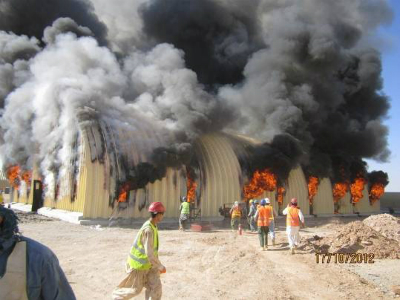BY Kelly Cohen
Money doesn't grow on trees, but it can certainly burn like them.
The U.S. Army Corps of Engineers has spent $1.57 billion on nearly 2,000 buildings for the Afghan National Army — but as many as 1,600 are at risk of catching on fire, according to the Special Inspector General for Afghanistan Reconstruction.
The use of a foam insulation poses a "significant fire hazard" to the buildings, used by the Afghan army as medical clinics, barracks and even fire stations, according to SIGAR.

Fire consumes an arch-span building at Afghan National Army Brigade Camp Sayar in Afghanistan in 2012. The incident report on the fire said the building, which was 85 percent complete, burned in 30 minutes. (Photo: U.S. Army Corps of Engineers via SIGAR)
The Corps has fixed almost 700 of the buildings, called two arch-span facilities, but the rest remain at risk, according to the IG.
Taxpayers will be left with the $50 to $60 million price tag to fix the buildings, even though the problem resulted from the Corps' failure to "enforce and properly administer its own contracts," according to SIGAR.
"I am also concerned that USACE must now spend millions of taxpayer dollars correcting this problem,” Inspector General John F. Sopko said in the report.
The Corps' Maj. Gen. Michael Eyre said in a January memo the risk of giving the buildings to ANA was "acceptable," because “the typical occupant populations for these facilities are young, fit Afghan soldiers and recruits who have the physical ability to make a hasty retreat during a developing situation.”
Eyre authorized transfer of the buildings to the ANA in the same memo.
Sopko said he was "troubled" by such logic and recommended that Eyre rescind the transfer.
"I am concerned that the rush to complete these buildings has led [the Corps] to disregard its own safety standards and, in so doing, has jeopardized the lives of ANA personnel," Sopko said.
Fires destroyed two arch-span facilities under construction in October 2012, prompting the SIGAR investigation.



